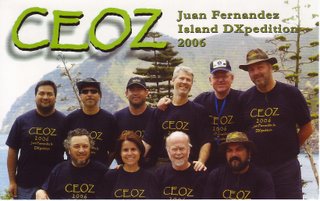JUAN FRENANDEZ Isl.
|
Good QSO's on 24 Mhz SSB, 21 Mhz SSB, 14 Mhz SSB / RTTY and
10 Mhz CW
Tks to F6AJA
This island, also known as Juan Fernández Island, is located in the archipelago of Juan Fernández, 414 miles off the coast of South America. It owes its name to the story of the shipwreck of Alexander Selkirk, immortalized in the famous novel "Robinson Crusoe', by Daniel Defoe.True to its description in the story, the island is a fascinating lost paradise, with an endemic flora and fauna that is unknown in other latitudes. Seventy percent of the plant species in the island are endemic, and you may see the Juan Fernández fur seal or the Juan Fernandez firecrown, both unique to this area.
The archipelago is currently a World Biosphere Reserve. Its landscape does justice to the novel, with peaks rising 1,500m above sea level, paths for walks and a beach with temperate waters where one can swim or scuba dive in places where there are sunken ships or fish for lobster. The island is utopia come to life. The island receives a special kind of tourist such as naturalists or people who dive for sport and also demanding adventurers because there are very few comforts to be found here. Instead, you may enjoy a savage and virgin nature that captivates and causes quite an impression on everybody who goes there.
Attractions and History:This remote, uninhabited archipelago entered the history books in 1575, when Portuguese sailor Juan Fernández, sailing between Pen and Valparaiso, deviated from his standard course and sighted the islands by chance. Occasionally visited by pirates and explorers, the island gained lasting fame beginning in 1708, when Scotsman Alexander Selkirk was rescued after four years marooned on the island; Selkirk's account of the ordeal sparked the imagination of Daniel Defoe, who used it as the basis for his famous novel, Robinson Crusoe. GeologyLike Easter Island, Juan Fernández is of volcanic origin, dating from about 3 million years ago; one of the submarine volcanos near the same 'hotspot' erupted in 1835. The three islands of the archipelago - Robinson Crusoe, Santa Clara, and Alexander Selkirk - rise steeply out of the Pacific, with few beaches and a limited number of protected bays, possibly formed by ancient volcanic craters.
Flora and fauna:
Over 70% of the plant species found in Robinson Crusoe's forest ecosystems are endemic, meaning that they are found nowhere else in the world. Giant ferns known as palmillos, the endemic chonta palm, and a wide variety of climbing vines are among the island's most noteworthy flora; the aromatic sandalwood tree, now extinct on the island, was last observed in 1908. The island's fauna is no less remarkable, with three endemic landbirds including the spectacular Juan Fernandez firecrown, a native hummingbird and a rich marine ecosystem with innumerable schooling fish and a recovering population of Juan Fernandez fur seals, hunt near extinction during the 19th century. Plants and animals introduced from the mainland, which have long threatened the integrity of native ecosystems, are being eliminated from the island in an ambitious project funded in part by the Dutch government.


0 Comments:
Post a Comment
<< Home